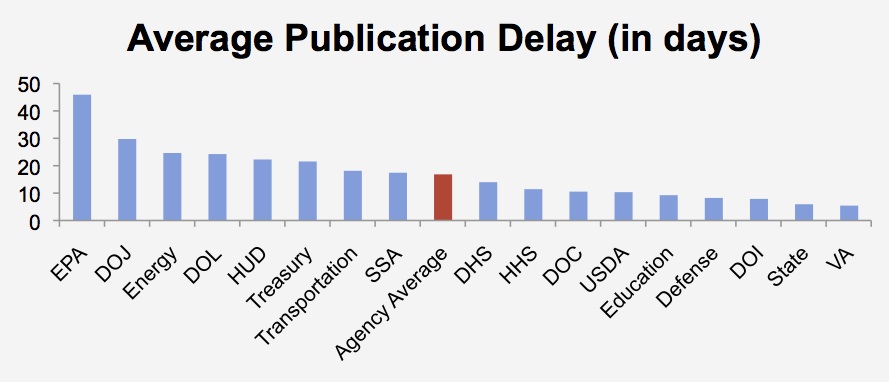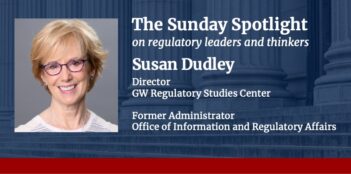
New model aims to predict how long it takes rules to be published after they clear OIRA review.
There are plenty of data examining the possible causes and explanations for why regulations spend months under review at the White House’s Office of Information and Regulatory Affairs (OIRA). However, few studies examine what happens to regulations when they leave OIRA and head to publication at the Federal Register. It can sometimes take weeks if not months for a rule to be published, even after it has cleared OIRA review.
What explains why it takes some rules so long to appear in print? We have completed new research that offers some insights, and we have constructed a statistical model that may help the public to know when to expect rules to be published.
We reviewed 491 “economically significant” and “major” rules from 2004-2014, finding that the average publication delay – that is, the gap between conclusion of OIRA review and formal publication in the Federal Register – amounted to 16.9 days. On the extremes, the U.S. Environmental Protection Agency (EPA) has an average publication delay of almost 46 days across its rules, compared to just 5.5 days for the U.S. Department of Veterans Affairs. The graph below details the variation between agencies.

Our data show the agencies that are responsible for above-average delays. To pick a concrete example, consider a recent rule issued by the Department of Labor’s U.S. Occupational Safety and Health Administration (OSHA) for “Electrical Protective Equipment.” OIRA concluded its review of the OSHA rule on December 20, 2013, but the rule was not published until April 11, 2014, a delay of 111 days. The rule did spend more than 500 days at OIRA and, admittedly, it was a lengthy final rule, clocking in at 429 pages in the Federal Register.
Perhaps OIRA review or a rule’s length can help explain why long delays like these can occur. We investigated the possible sources of delays by analyzing our entire sample of rules, testing whether delays related with a variety of potentially relevant independent variables. The variables we tested were:
- Length of OIRA review
- Number of comments received
- Status under the Unfunded Mandates Reform Act (UMRA) (as a proxy for “expensive”)
- Number of pages in the Federal Register
- Whether the rule was published during a congressional recess
- Whether the rule was published during an election year.
To measure the relationship between each of the six variables above and publication delay, we employed a linear regression model. We found rules are substantially delayed when they experience longer OIRA review, have lengthier documents, receive more comments, and rise above the $100 million cost threshold provided in UMRA.
For example, a hypothetical rule that is reviewed by OIRA for 30 days, receives 10,000 comments, is 120 pages long, and triggers UMRA should experience a delay of 21 days. In other words, that would be three weeks from discharge at OIRA to formal publication.
Overall, we find our model predicts a delay that is within five to seven days of the actual delay. For instance, EPA’s CAFE standards issued in 2012 spent 42 days at OIRA, received more than 370,000 comments, triggered UMRA, and consumed 578 pages. EPA delayed the rule’s publication by 48 days, compared to our model’s prediction of a 41-day publication delay.
For other rules, the regression yields even more accurate predictions of delay, coming within two to four days of actual delay. For example, in 2011 the Department of Energy published an efficiency rule for fluorescent lamp ballasts. Our model predicts that a rule with the same amount of review time (15 days), the same volume of comments (27), an equivalent number of pages (83), and that also triggered UMRA should have a delay of 14 days. The efficiency standard rule had an actual publication delay of 16 days.
Of course, our model is unable to predict the delay for all rules. In particular, it tends to predict delays far shorter than actual for rules that are delayed for extended periods. Those cases may involve other aspects of the rulemaking process for which we have not accounted. For example, some rules with a judicial deadline experienced delays exceeding 80 days. A 2014 EPA rule on standards for cooling water intake structures had a publication delay of 86 days, compared to our model’s prediction of a 31-day delay. Perhaps controlling for statutory or judicial deadlines could yield more accurate predictions, but there will always be some rulemakings that, for a variety of extraneous factors, are true outliers.
Our ultimate goal in conducting this analysis is to be able to predict, and attempt to explain, future regulatory delays. We will be putting our model to the test when future rules are released from OIRA. There are undoubtedly various factors that lead to publication delays, and perhaps individual anecdotes can inform and further refine our model. Expansion of the project could apply to publication of proposed rules and perhaps even to OIRA wait times.
Whether publication delays are a matter of pure politics or more nuanced issues of document length and legal or administrative hurdles remains an open question. We hope this research has at least begun to identify notable trends in delay and the substantive factors that can explain why some rules languish for months in regulatory limbo.





